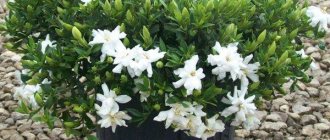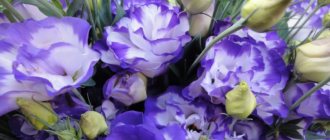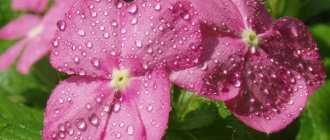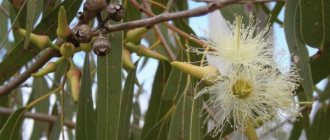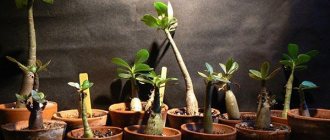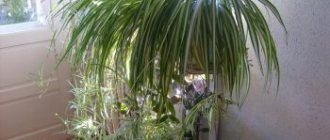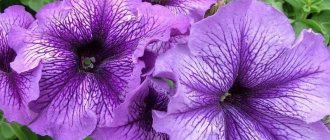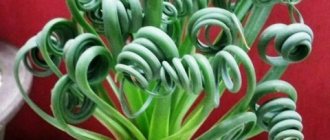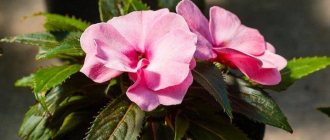Gardenia is an evergreen plant in the form of a bush. A beautiful leafy cap of rich green color will not leave anyone indifferent. And when the time comes to bloom, this beauty can outshine even a rose. Lush white flowers with an intoxicating jasmine scent make her the queen of the windowsill.
Like the real queen, gardenia is valued just as highly. However, if you are patient, you can try growing gardenia from seeds. This is a somewhat troublesome matter, since the flower has a capricious character and is demanding to care for.
Description of the flower
Gardenia is an evergreen shrub native to South America, East and Southeast Asia. Jasmine gardenia has taken root in temperate latitudes. The indoor flower grows up to 50 cm in height. The color is white, some varieties have a terry texture of the petals. It has a subtle, jasmine aroma that the plant emits during flowering. Just one flower is enough to fill a room with a unique fragrance. You can learn about other varieties of gardenia in another article.
The leaves are dark green, rich in color, with a smooth surface and a glossy sheen. Gardeners prefer gardenia for its decorative foliage that remains attractive throughout the year.
In order for your pet to please you for a long time and bring only benefits, we suggest that you read several articles about gardenia:
- Useful properties of the plant.
- Pests and diseases of gardenia.
- Problems with leaves and ways to solve them.
Reproduction methods
Today there are two known methods of propagating jasmine gardenia:
Seminal. With the seed propagation method, the main problem is the freshness of the seed; the germination of seedlings depends on this characteristic. It is worth recalling that gardenia seeds are poisonous; when planting with them, you need to be careful and use personal protective equipment. But the advantage of this method of propagation is the affordable price of seeds, which are easy to purchase at any flower shop.- Cuttings. With the vegetative propagation method, the woody upper parts of the shoots serve as planting material. In this case, the cuttings must certainly be healthy and not under stress. The shoots are rooted in the summer in mini greenhouses, after regular bush formation procedures. Such rooted young plants can bloom 6 months after transplanting into a pot.
Choosing seeds and soil for gardenia
In order to get young seedlings, you will need to choose the right soil and purchase high-quality seeds. It is better to buy seeds in specialized flower shops. This way you can be sure that the seeds will be fresh and they have been stored correctly.
Gardenia grows well only in loose and acidic soil. The plant belongs to the Rubiaceae family, for which there is a special substrate. You can also buy it in the store. Some gardeners claim that you can grow a flower using azalea soil mixture.
When does it reproduce?
The optimal period for sowing planting material is the end of February - the beginning of March. At this time, the length of daylight increases significantly, and the weather becomes warmer. The germination period of seeds varies within 30-40 days from the moment of sowing.
Before planting, the soil must be warmed up so that it becomes warm. You can also sow seeds in the summer, but then it is important to monitor the temperature so that the germinated seedlings do not get too hot. Otherwise it will simply dry out.
Recommendations for cultivation
Growing gardenia from seeds is a long and labor-intensive procedure. As already mentioned, the main factor influencing the similarity of seedlings is the freshness of the seeds, so when purchasing, pay attention to the packaging date indicated on the package. However, there are cases that out of 5 purchased seeds, only 1-2 pieces germinate.
If you want to get the seeds yourself, then it is important to know:
- gardenia blooms in the 5th year of life, but it is possible earlier with quality care (you will learn about why gardenia does not bloom and what needs to be done in this article);
- the flowering period lasts from March to September;
- at the end of flowering, seed boxes appear;
- the shape of the seed is oval, with one end pointed and the other round;
- the average seed size is 4-5 mm;
- the color of high-quality fresh material is light and dark brown;
- after collecting the boxes, they should be dried well and subsequently stored in a dry place where there is no access to moisture;
- The shelf life of seeds is no more than 2-3 years.
How to get grains
Growing an exotic shrub from seeds is a complex and painstaking procedure that takes a lot of time. One of the success factors is fresh and high-quality seed material.
The flowering age of gardenia is 5 years, sometimes with good care it blooms earlier. Fragrant petals open in July and delight the eye until September. After the buds bloom, dry seed pods appear.
The diameter of the seed is 4-5 mm, its shape is similar to a lemon. One tip is sharp and the other is blunt, the surface is ribbed. The color of the seeds is light and dark brown.
If you buy seeds from flower growers, then it is worth considering them; they should be intact, without damage or signs of rotting. When purchasing material in a specialized store, you can only hope for luck. There are times when out of 5 seeds placed in a bag, 1-2 sprout.
How to grow at home?
So, to grow an exotic beauty at home, you can follow 2 ways:
- buy an adult plant at a flower shop;
- Try growing seedlings from seeds yourself.
The first option is certainly simpler and more reliable. And the seed method is suitable for purposeful flower lovers, and you can still save a considerable amount. After all, a full-fledged plant costs tens of times more than a bag of seeds.
So, before starting the planting process you should prepare:
- fresh gardenia seeds;
- wide, shallow container;
- fine fraction drainage;
- earthen mixture for azaleas, this particular substrate is optimal for young gardenias;
- the warmest place in the house.
Let's break it down step by step:
- The first step is to prepare the soil; you can take a ready-made substrate or make it yourself. In this case, you will need in equal proportions: peat, sand and deciduous soil (you can find out how to choose soil for gardenia, as well as what pot you need when planting, here). Move all components carefully. In winter, the soil should be warmed to room temperature.
- A drainage layer 4-5 cm thick is placed at the bottom of the prepared container. Soil is poured on top. The soil is watered abundantly, then the seeds are spread evenly.
- A day before planting, the seeds are soaked in warm boiled water with the addition of the stimulant Kornevin, 3 drops of liquid preparation per 100 ml of water. Then the seeds are carefully planted in the soil; it will be more convenient to use tweezers. The distance between the seeds is 3-4 cm, and the depth is no more than 5 cm.
- A dry layer of soil is sprinkled on top of the sowing. You can not water the soil in advance, but after planting, spray the soil with water from a spray bottle.
- Cover the container with a clear plastic bottle or plastic bag to maintain greenhouse conditions. Then move the pot to a warm place. Make sure that the temperature in the greenhouse is +20-24°C and high humidity, which is created by regular spraying with water. Don’t forget to ventilate the greenhouse daily and remove condensation.
Reference! Many sources indicate germination time as 1 month, but in practice, seedlings germinate much faster.
Diseases and pests
The jasmine gardenia, which requires care, often causes difficulties for gardeners who are not accustomed to growing such plants. Mistakes made when growing this shrub can be judged by the following external signs:
- Buds and flowers fall off - the reason may be moving the pot, untimely pruning or replanting, as well as insufficiently high temperature in the room;
- Buds fall off - the room with bushes is too cold or hot;
- The foliage turns yellow - the loss of green color may be due to watering with cold or too hard water. The water temperature for watering the flower should be room temperature; in addition to settling, it can also be acidified;
- The edges of the leaves darken and dry out - a sign of dry air and irregular watering;
- Dark spots form on the foliage - the plant is watered too often, under such conditions rot can develop on the roots.
Gardenia can also be attacked by pests. Most often, scale insects, thrips or spider mites can be seen on the plant. They should be combated with the help of appropriate drugs.
What to do after germination?
When the young plants get stronger and several leaves appear, it’s time to pick. That is, planting sprouts in separate containers. Small glasses or pots with a diameter of no more than 10 cm are suitable for this; it is advisable to cover the top with cut plastic bottles. After all, the sprouts are not yet ready for the indoor microclimate.- After a month, remove the bottles and perform the first feeding. Make the fertilizer concentration 2 times weaker than indicated in the instructions, in order not to overfeed the plant.
- Every 10 days, spray the leaves with Ferovit to prevent chlorosis. When watering, you need to add lemon juice to the water, thus acidifying the soil. Add 4-5 drops of juice to 1 liter of water. Instead of juice, you can use citric acid.
- To make the bush voluminous, the upper shoots should be pinched.
- After a year, it is worth changing the place of residence of the flower.
- In the future, care for it in the same way as for an adult gardenia.
As it turned out, germinating gardenia seeds at home is not such an impossible task. The main thing is to want it and everything will certainly work out. Perhaps not all seedlings will survive the first time, but with time and experience gained, the result will improve noticeably.
Beneficial properties of gardenia jasmine
Gardenia jasminoides is not only a beautiful, but also a useful plant. Traditional healers use its roots and foliage to prepare various medicinal compositions. They help with ulcers, mastitis and bleeding, and can also reduce fever. Gardenia may include remedies for hepatitis and esophageal diseases.
Residents of Asian countries eat parts of gardenia for food. So in Korea, the fruits of the bush serve as a dye for jelly: they give it a yellow color.
Indoor plants Flowering indoor plants
